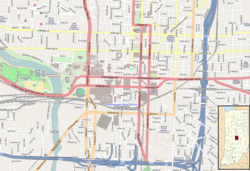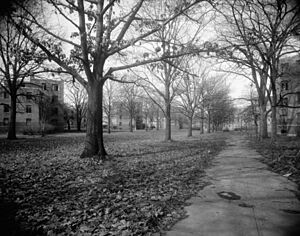Lockefield Gardens facts for kids
Quick facts for kids |
|
|
Lockefield Garden Apartments
|
|

Two of the buildings in the complex
|
|
| Location | 900 Indiana Avenue, Indianapolis, Indiana |
|---|---|
| Area | 9.5 acres (3.8 ha) |
| Built | 1935 |
| Architect | Russ, William E.; Harrison, Merritt |
| Architectural style | International Style |
| NRHP reference No. | 83000133 |
| Added to NRHP | February 28, 1983 |
Lockefield Gardens was the first public housing project built in Indianapolis. It was built between 1935 and 1938. This housing was created especially for African-American families with lower incomes in Indianapolis. The complex closed in 1976. Many buildings were taken down in the early 1980s. Today, only the original buildings along Blake Street are still standing.
Contents
Why Was Lockefield Gardens Built?
During the 1930s, the United States was in a tough economic time called the Great Depression. President Franklin D. Roosevelt created a plan called the New Deal. This plan aimed to help the country recover. Part of the New Deal involved the Public Works Administration. This group started funding new, affordable housing projects. These projects were built in twenty states. They replaced older, run-down areas known as "slums."
Indianapolis was chosen for one of these important projects. It would be the first major public housing in Indiana's capital city. The land chosen for Lockefield Gardens had 363 homes before. Most of these homes were in very poor condition. Another goal of the project was to create jobs. About 9,000 temporary construction jobs were made in the area. This project went ahead even though some Indiana politicians worried it would harm private businesses.
Building a New Community
About three million dollars were spent to build Lockefield Gardens. It officially opened in February 1938. The project covered twenty-two acres along Indiana Avenue. It had 748 separate homes. The Russ and Harrison architecture firm designed the buildings. The N. P. Severin Company of Chicago built them. The designs were based on ideas from Europe.
The complex had twenty-four buildings. They were two to four stories tall. The Public Works Administration used special building designs called "corner," "strip," and "tee" models. Lockefield Gardens offered many great features. It had a central open area, four playgrounds, and thirteen smaller play spots. There was also a school, William D. McCoy Public School #24. A small shopping area was also part of the complex. The homes had good air flow, lots of natural sunlight, and nice views. Rent for these homes ranged from $20.80 to $30.10 each month.
Lionel Artis was the first manager of the apartments. He managed Lockefield Gardens for over thirty years, until 1969. After it was built, Lockefield Gardens was seen as one of the best New Deal housing projects. It was unusual because it had wide, open spaces. Many other New Deal housing projects were much more crowded.
Changes Over Time
When Lockefield Gardens first opened, it was only for African-American residents. This gave them a strong, community-focused place to live. Lockefield Gardens became a central part of the black community in northwest downtown Indianapolis.
In the 1950s, racial equality began to improve. More African-Americans started moving into neighborhoods that were mostly white. Because of rules about income and more successful African-Americans moving out, Lockefield Gardens began to decline. In the 1970s, there was a plan to improve the area. However, a federal judge named S. Hugh Dillin believed this plan might continue to separate people by race in schools and homes. Because of this, the apartments closed in 1976.
In 1980, a decision was made about the Lockefield Gardens area. Part of it would be used for the expansion of Indiana University-Purdue University Indianapolis (IUPUI). This campus is part of both the Indiana University and Purdue University systems. Also, housing was needed for athletes coming to the Pan Am Games in Indianapolis.
In 1983, many buildings were torn down. Only the units along Blake Street and Locke Street (now University Boulevard) remained. This was despite protests from people in Indianapolis who wanted to save the historic buildings. The remaining buildings were then added to the National Register of Historic Places. Eleven new buildings were constructed. The original buildings were also updated. The complex now has 493 homes in total. This includes 199 homes in the original buildings.
Lockefield Gardens Today
Today, the Lockefield Gardens area is an apartment complex. It is located on the IUPUI university campus. Students and staff live there. Other working adults are also welcome to live in the apartments.







